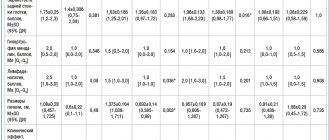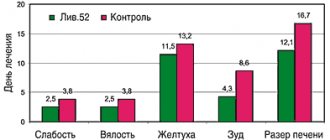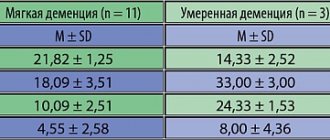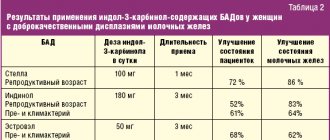Indications
For monotherapy of relapsing-remitting multiple sclerosis in the following groups of patients:
- patients with an active course of the disease, despite treatment with interferon beta. This group of patients can be defined as a group of patients who are not amenable to treatment with a full and adequate course (for at least one year) of interferon beta. They must have had at least one relapse during the previous year of therapy and at least 9 T2-hyperintense lesions on brain magnetic resonance imaging (MRI) or at least one lesion visible with gadolinium-containing MRI contrast agents. Patients “without response” to therapy should be understood as patients with an unchanged or increased frequency of exacerbations compared to the previous year, or current severe exacerbations, even with treatment lasting less than a year;
- patients with rapidly progressing severe relapsing-remitting multiple sclerosis (i.e., having had 2 or more exacerbations during the year and having 1 or more lesions on MRI of the brain that accumulate MRI contrast agents containing gadolinium, or a significant increase in the volume of the lesion in the mode T2 compared to previous MRI results).
Efficiency of use
A study was conducted on the effectiveness of natalizumab for patients with multiple sclerosis. Twelve people took part in the experiment, eight of whom stopped taking the drug for one reason or another. The treatment period ranged from ten to twenty-eight months. Two patients from the entire group experienced exacerbations during the use of natalizumab. In one patient, an exacerbation occurred after the first infusion, in another - after the thirteenth. Exacerbations were controlled with pulse therapy with methylprednisolone. Data from the remaining patients indicate the high effectiveness of natalizumab in terms of controlling the course of multiple sclerosis. Visible changes in pathology were observed both during the first and second courses of therapy.
Contraindications
- hypersensitivity to natalizumab or any of the excipients;
— progressive multifocal leukoencephalopathy (PML);
- increased risk of infection with opportunistic microorganisms, incl. immunodeficiency conditions (for example, patients receiving or receiving immunosuppressants such as mitoxantrone or cyclophosphamide, see also section "Special instructions");
- simultaneous use of interferon beta or glatiramer acetate;
- malignant neoplasms, with the exception of basal cell skin cancer;
- children and teenagers.
Dosage
Tysabri therapy should be prescribed and closely monitored by physicians specializing in the diagnosis and treatment of neurological diseases in institutions with MRI capabilities.
Patients receiving Tysabri should be given a special patient card and informed of the risks of this drug. After 2 years of treatment, patients should be re-informed about the risks of Tysabri, especially the increased risk of PML. Caregivers should also be informed about the early signs and symptoms of PML.
Medical institutions should have everything necessary in case of hypersensitivity reactions and equipment for MRI.
After dilution, the solution is administered in the form of infusions over about an hour; During infusions and for an hour after it, patients should remain under observation due to the possibility of hypersensitivity reactions.
Bolus administration of Tysabri is not permitted.
In the absence of treatment-related abnormalities, such as neutropenia, patients receiving interferon beta or glatiramer acetate can be switched directly to natalizumab. If abnormalities are present, natalizumab therapy can be started only after the parameters return to normal.
Some patients may have previously received immunosuppressive drugs (eg, mitoxantrone, cyclophosphamide, azathioprine). These drugs can cause a long-term immunosuppressive state that persists even after their discontinuation. Therefore, before prescribing Tysabri, it is necessary to ensure that the patient does not have an immunodeficiency.
If there are no signs of improvement after 6 months, the advisability of continuing therapy should be carefully assessed.
Data on the safety and efficacy of natalizumab over 2 years were obtained from controlled, double-blind studies. The decision to extend therapy beyond this period should be made only after assessing the balance of possible risks and benefits.
Adults
Tysabri 300 mg is administered intravenously as an infusion once every 4 weeks.
Elderly people
The use of Tysabri in patients over 65 years of age is not recommended due to the lack of safety data in this category of patients.
Children and teenagers
Tysabri is contraindicated in children and adolescents.
Patients with impaired renal and liver function
No studies have been conducted to evaluate the effects of the drug in impaired liver and kidney function.
The mechanism of elimination and the results of pharmacokinetic studies suggest that the drug can be prescribed to patients with impaired renal and hepatic function without changing the dose.
Re-introduction
The effectiveness and safety of the drug upon repeated administration have not been determined.
Rules for the preparation, administration, storage and disposal of the drug
1. Before dilution and administration, inspect the drug for the presence of solid impurities. Do not use a product that contains solid particles or does not meet the description of a “colorless, clear or slightly opalescent solution.”
2. Prepare the solution for internal administration under aseptic conditions. Remove the top cap from the bottle. Puncture the plug in the center with a syringe needle and withdraw 15 ml of concentrate to prepare a solution for intravenous administration.
3. Add 15 ml of concentrate to 100 ml of 0.9% sodium chloride solution. Carefully invert the bottle several times to mix the contents. Don't shake.
4. Do not mix Tysabri with other solvents and medications.
5. Before administration, inspect the diluted solution for particulate matter or discoloration. A solution with foreign impurities or discoloration is unsuitable for use.
6. The diluted drug must be used as soon as possible and no later than 8 hours after dilution. If the solution was stored at a temperature of 2-8°C (was not frozen!), allow it to warm to room temperature before infusion.
7. The diluted solution is administered as an infusion over approximately 1 hour at a rate of approximately 2 ml/min.
8. After completing the drug administration, rinse the system with 0.9% sodium chloride solution.
9. Each bottle is for single use only.
10. Any unused product or waste should be disposed of in accordance with local regulations.
basic information
Active ingredient: natalizumab 20.0 mg/ml. Auxiliary components:
- Sodium dihydrogen phosphate monohydrate 1.13 mg/ml,
- sodium hydrogen phosphate heptahydrate 0.48 mg/ml,
- sodium chloride 8.20 mg/ml,
- polysorbate 80 (E433) 0.20 mg/ml,
- water for injection 983.00 mg/ml.
Appearance: concentrate for the preparation of a solution for infusion in the form of a colorless or slightly opalescent solution. Pharmacotherapeutic group: monoclonal antibodies. Average price for the drug Natalizumab in Russia: 90,000.00 rubles. Country of origin: USA, UK, Germany, Denmark, Belgium, Russia. A detailed description and detailed instructions for use of the drug for patients are presented below.
Mechanism of action
The active substance of the drug Tysabri (Natalizumab) is a selective inhibitor of adhesion molecules (membrane receptors that are involved in the binding of cells to other cells). The substance binds to the alpha-4 subunit of human integrin (cellular receptor). Integrin is formed in large quantities on the surface of all leukocytes, except neutrophils.
Natalizumab creates a specific binding to alpha-4-beta-1 integrin, thereby blocking the interaction with this receptor, vascular cell adhesion molecule (VCAM-1) and the osteopontin ligand, fibronectin domain, which is formed as a consequence of alternative splicing, junctional segment-1 (CS-1). Natalizumab also blocks the interaction of alpha-4-beta-7 integrin with the mucosal adhesion molecule addressin-1 (MadCAM-1). Disruption of these molecular bonds prevents the entry of leukocytes into areas of inflammation. The further mechanism of action of the drug may be due to the elimination of inflammation in the affected tissues. This occurs by inhibiting the interaction of alpha-4-expressing leukocytes with associated molecules in the extracellular space and on parenchymal cells. Using this mechanism, natalizumab can eliminate inflammation in affected tissues and prevent further entry of leukocytes into the site of inflammation.
Side effects
Infections and infestations:
urinary tract infections, nasopharyngitis.
Immune system disorders:
urticaria, hypersensitivity.
Nervous system disorders:
headache, dizziness.
Gastrointestinal disorders:
vomiting, nausea.
Musculoskeletal and connective tissue disorders:
joint pain.
General disorders and reactions at the injection site:
chills, fever, fatigue.
Hypersensitivity reactions:
According to a two-year controlled clinical study on patients with MS, the incidence of hysteresthesia reached 4%. Anaphylactic/anaphylactoid reactions have been reported in less than 1% of patients receiving Tysabri. Hypersensitivity reactions usually occur during the infusion or within an hour after it.
Immunogenicity:
During a two-year controlled clinical trial, antibodies to natalizumab were detected in 10% of patients with MS. Circulating antibodies to natalizumab (double positive) were detected in approximately 6% of patients. A single positive result was observed in another 4% of patients. Circulating antibodies reduce the effectiveness of Tysabri and increase the incidence of hypersensitivity reactions. Other infusion reactions due to circulating antibodies included chills, nausea, vomiting, and flushing. If circulating antibodies are suspected after approximately 6 months of therapy, either due to decreased efficacy or an infusion reaction, another test should be performed 6 weeks after the first positive result. Given the possible decrease in effectiveness or increase in the frequency of hypersensitivity reactions in patients with circulating antibodies, treatment should be discontinued.
Infections, including PML and opportunistic infections:
According to a two-year controlled clinical trial in patients with MS, the infection rate was approximately 1.5 per patient-year in both the natalizumab and placebo groups. The nature of infections in both groups was approximately similar. A case of diarrhea due to Cryptosporidium has been reported. Other opportunistic infections, including deaths, have been reported in other clinical studies. During clinical trials, the natalizumab-treated group had a slightly higher incidence of herpesvirus infections (herpes zoster virus and herpes simplex virus) than the placebo group. During early post-marketing surveillance, one fatal case of herpesvirus encephalitis was reported.
The majority of patients who develop infections do not discontinue natalizumab therapy and, with appropriate treatment, recover.
Cases of PML have also been reported during clinical trials. They usually resulted in severe disability or death. During pivotal clinical trials, two cases, including one death, were reported in patients with PC with concomitant infection who were treated with interferon beta for more than 2 years. In another trial, PML developed in a patient with Crohn's disease who was chronically treated with immunosuppressive drugs and had lymphopenia and died. The development of PML was observed in a post-marketing study in patients receiving Tysabri as monotherapy.
Liver reactions:
During the post-marketing surveillance period, spontaneous reports of cases of serious liver damage, increased activity of liver enzymes and hyperbilirubin were received.
Malignant neoplasms:
over more than 2 years of therapy, there were no differences in the incidence of malignancies between the natalizumab and placebo groups. However, longer studies are needed to completely rule out the effect of natalizumab on the incidence of malignancy.
Effect on laboratory parameters:
treatment with Tysabri is accompanied by an increase in the number of lymphocytes, monocytes, eosinophils, basophils and nuclear forms of erythrocytes in the circulating blood. No increase in neutrophil concentration was observed. The increase in the number of lymphocytes, monocytes, eosinophils and basophils reaches 35-140% compared to the initial value, but the total number of cells remains within normal limits. During TYSABRI therapy, there was a slight decrease in hemoglobin concentration (mean decrease 0.6 g/dL), hematocrit (mean decrease 2%) and red blood cells (mean decrease 0.1 x 106/L). Typically, within 16 weeks after the last dose of Tysabri, all hematological parameters returned to baseline values and these changes were not accompanied by clinical symptoms.
Drug interactions
The safety and effectiveness of Tysabri in combination with other immunosuppressants or anticancer drugs has not yet been well established. Concomitant use of these drugs may increase the risk of infection, including opportunistic pathogens, and is therefore contraindicated.
Patients who have previously received immunosuppressant therapy are at increased risk of developing PML. The drug should be prescribed to patients who have previously received immunosuppressants with caution; it is necessary to wait for the restoration of immune system function. Before prescribing Tysabri, the treating physician should evaluate each individual case to identify possible signs of immunodeficiency.
According to the results of the 3rd phase of clinical trials in patients with MS, concomitant treatment of relapse with a short course of glucocorticosteroids was not accompanied by an increase in the incidence of infections. Thus, short-term therapy with glucocorticosteroids can be carried out in parallel with Tysabri therapy.
Incompatibility
Tysabri should not be mixed with other medications, with the exception of 0.9% sodium chloride solution.
Immunization
In randomized, open-label studies conducted in 60 patients with multiple sclerosis, there were no significant differences in the immune response of patients to the administered antigen. Comparisons were made between groups of patients treated with Tysabri for 6 months and a control group not treated with Tysabri.
Transportation and storage conditions
Tysabri natalizumab should not be frozen. The optimal temperature for storing ampoules and the finished solution is from two to eight degrees Celsius. Immediately before infusion, be sure to allow the product to warm to room temperature. After the infusion, the system should be flushed with saline solution. The ampoule is intended for single use. Tysabri should be kept out of the reach of children and in a dark place. Exposure to direct sunlight is not recommended. The concentrated substance can be stored for four years. Diluted solution – no more than eight hours. Any waste or expired products must be disposed of in the designated area.
special instructions
Progressive multifocal leukoencephalopathy (PML)
Use of Tysabri may increase the risk of developing PML and may result in death or severe disability.
The risk of PML increased with the duration of treatment, especially when treated with the drug for more than 2 years. Currently, data on patients receiving Tysabri for more than 3 years is limited, so it is currently impossible to assess the risk of PML in this group of patients.
The risk of PML is increased in patients who were treated with immunosuppressants before using Tysabri. This risk is independent of the duration of treatment with Tysabri.
Due to the increased risk of developing PML, the physician and patient should individually consider the benefit-risk ratio of treatment with Tysabri. Before starting to work with Tysabri, the doctor must complete training in the program “Use of Tysabri and monitoring patients undergoing treatment.”
After 2 years of treatment, patients should be re-informed about the risks of Tysabri, especially the increased risk of PML. Both patients and caregivers should also be educated about the early signs and symptoms of PML.
Tysabri therapy should be started only if there are results of an MRI performed no earlier than 3 months before the start of therapy. This MRI is basic.
It is necessary to organize regular monitoring of the patient throughout treatment in order to timely detect the emergence of new neurological symptoms characteristic of PML or worsening of existing ones.
If new neurological symptoms appear, therapy should be suspended until PML is ruled out.
The attending physician should continue to monitor the patient to identify possible symptoms of neurological dysfunction and, if present, determine whether they are typical for MS and whether they are a reason to suspect PML. In the latter and other doubtful cases, further diagnostic testing is necessary, including MRI (the results of which should be compared with the results of the baseline MRI before treatment with natalizumab), examination of the cerebrospinal fluid (CSF) for the presence of polyomavirus DNA (JC virus), and a repeat neurological examination. If PML is not confirmed, natalizumab therapy can be restarted.
The attending physician should be especially attentive to symptoms of PML that may go unnoticed by the patient himself (for example, symptoms of cognitive or psychiatric impairment). The patient should be advised to notify close relatives or caregivers that he is being treated; they may be able to notice symptoms that went unnoticed by the patient.
If PML develops, Tysabri therapy should be discontinued completely.
In patients with PML with immunosuppression, after immune restoration, improved clinical outcomes are observed.
PML and immune reconstitution inflammatory syndrome (IRIS)
Almost all patients treated with Tysabri who developed PML and subsequently discontinued Tysabri experienced IRIS. Plasmapheresis is used to rapidly reduce natalizumab concentrations when PML is detected.
IRIS is a result of immune reconstitution in patients with PML, which can lead to serious neurological complications as well as death.
Close monitoring for IRIS, which usually develops within days to weeks after plasmapheresis in patients with PML treated with Tysabri, should be performed, along with appropriate anti-inflammatory treatment during recovery from PML.
Other infections by opportunistic microorganisms
Other infections with opportunistic microorganisms have been described with the use of Tysabri, mainly in Crohn's disease, immunodeficiency states and concomitant diseases, however, such infections can develop in the absence of concomitant diseases. Infections with opportunistic microorganisms have also been described in patients with MS treated with Tysabri monotherapy.
When prescribing the drug, it is necessary to remember the possibility of developing infection with opportunistic microorganisms, which should be included in the list of differential diagnoses. If infection with opportunistic microorganisms is suspected, therapy with Tysabri should be suspended until infection has been ruled out based on the results of appropriate studies.
If infection with opportunistic microorganisms develops, Tysabri therapy should be completely discontinued.
Tutorials
The physician should discuss the benefits and risks of Tysabri therapy with the patient and provide the patient with a special card containing important safety information. Patients should be instructed that if an infection develops, they should notify their prescriber about the use of Tysabri.
Doctors should explain to the patient the importance of continuous treatment, especially in the first months of treatment.
Hypersensitivity
Tysabri may cause hypersensitivity reactions, including serious systemic reactions. These reactions usually develop during the infusion or within an hour after it. The risk of developing hypersensitivity is greatest at the beginning of infusions, as well as when Tysabri is re-administered after a long break (three months or more) following the first short-term course (one or two infusions). However, the risk of hypersensitivity reactions should be considered with any infusion.
Patients should remain under observation during infusions and for an hour after their completion. The medical facility must have everything necessary to treat hypersensitivity reactions.
At the first sign of a hypersensitivity reaction, the administration of Tysabri should be discontinued and treatment measures should be started immediately.
Patients who develop hypersensitivity reactions should immediately discontinue Tysabri therapy.
Concomitant or previous treatment with immunosuppressants
The safety and effectiveness of Tysabri in combination with other immunosuppressants or anticancer drugs has not yet been well established. Concomitant use of these drugs may increase the risk of infection, including opportunistic pathogens, and is therefore contraindicated.
Patients treated with immunosuppressants are at increased risk of developing PML. The drug should be prescribed to patients who have previously received immunosuppressants with caution; it is necessary to wait until the immune system functions to recover. Before prescribing Tysabri, the treating physician should evaluate each individual case to identify possible signs of immunodeficiency.
According to the results of phase 3 clinical trials in patients with MS, concomitant treatment of relapse with a short course of glucocorticosteroids was not accompanied by an increase in the incidence of infections. Thus, short-term therapy with glucocorticosteroids can be carried out in parallel with Tysabri therapy.
Immunogenicity
Worsening of disease symptoms or adverse reactions to infusion may indicate the development of antibodies to natalizumab. If such phenomena occur, it is necessary to test for antibodies to natalizumab twice with an interval of 6 weeks; if the result remains positive after 6 weeks, therapy should be discontinued as the persistent presence of antibodies reduces the effectiveness of Tysabri and increases the likelihood of hypersensitivity reactions.
Since there is an increased risk of hypersensitivity reactions upon re-administration with a long treatment interruption after a short course of Tysabri, antibody testing should be performed and if the confirmatory test remains positive after 6 weeks, therapy should not be restarted.
Liver reactions
Spontaneous serious hepatic adverse events were reported during post-marketing surveillance. Liver damage is possible at any time during the course of treatment, even after the first dose. In some cases, the reaction occurred again when Tysabri therapy was resumed. Some patients with a history of liver disease have experienced worsening liver function tests during Tysabri therapy. Patients should be closely monitored for possible liver dysfunction and warned to contact their physician if symptoms of liver damage, such as jaundice and vomiting, occur. If significant liver damage occurs, Tysabri therapy should be discontinued.
Withdrawal of Tysabri therapy
If the prescribing physician decides to discontinue natalizumab therapy, the physician should be aware that the drug remains in the circulation and continues to exert pharmacodynamic effects (eg, lymphocytosis) for approximately 12 weeks after the last dose. If other medications are prescribed during this period, they may interact.




